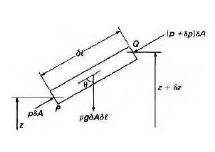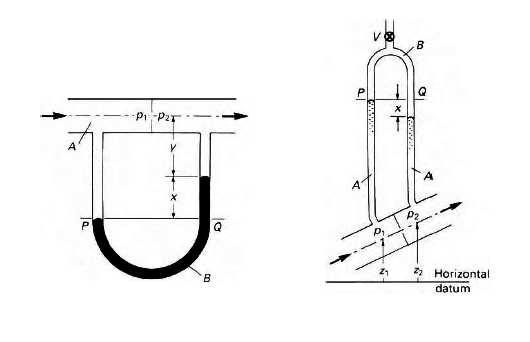Distribution of Pressure in the Fluid
Consider a small cylinder of fluid PQ as illustrated in Fig.(1) [2]. If the fluid is at rest, the cylinder must be in equilibrium and the only forces acting on it are those on its various faces (due to pressure), and gravity. The cross sectional area δA is very small and the variation of pressure over it therefore negligible. Let the pressure at the end P be p and that at the end Q be p + δp. The force on the end P is therefore pδA and the force on the end Q is (p + δp)δA. If the length of the cylinder is δl its volume is δAδl and its weight gρδAδl where ρ represents the density and g the acceleration due to gravity. Since no shear forces are involved in a fluid at rest, the only forces acting on the sides of the cylinder are perpendicular to them and therefore have no component along the axis. For equilibrium, the algebraic sum of the forces in any direction must be zero. Resolving in the direction QP:
(p + δp)δA + gρδAδl cos Θ = 0 (1)
Now if P is at a height z above some suitable horizontal datum plane and Q is at height z + δz, then the vertical difference in level between the ends of the cylinder is δz and δl cos Theta = δz. Equation (1) therefore simplifies to

Figure 1:
![]()
and in the limit as δz → 0
![]()
The minus sign indicates that the pressure decreases in the direction in which z in- creases, that is, upwards. If P and Q are in the same horizontal plane, then δz = 0, and consequently δp is also zero whatever the value of ρ. Then, in any fluid in equilibrium, the pressure is the same at any two points in the same horizontal plane , provided that they can be connected by a line in that plane and wholly in the fluid. In other words, a surface of equal pressure (an isobar) is a horizontal plane.
A further deduction is possible from (3). If everywhere in a certain horizontal plane the pressure is p, then in another horizontal plane, also in the fluid and at a distance δz above, the pressure will be p+∂p/δz. Since this pressure also must be constant throughout a hor- izontal plane, it follows that there is no horizontal variation in ∂p/δz , and so, by (3), neither does ρg vary horizontally. For a homogeneous incompressible fluid this is an obvious truth because the density is the same everywhere and g does not vary horizontally. But the result tells us that a condition for equilibrium of any fluid is that the density as well as the pressure must be constant over any horizontal plane . This is a foundation for the law of connected (communicating) vessels.
The pressure on the horizontal plane that goes through the to vessels which are connected, that it is means that to different points one can to join by the curve that always stay with the same fluid, is the same.
This is why immiscible fluids of different densities have a horizontal interface when they are in equilibrium.
There are, then, three conditions for equilibrium of any fluid:
- The pressure must be the same over any horizontal plane;
- The density must be the same over any horizontal plane;
- The pressure varies only in the vertical z direction as dp/dz =−gρ

Figure 2: The pressures by virtu of the connected vessels law, at the points P and Q are the same. On the left U-tube manometer, on the right inverted U-tube manometer.

